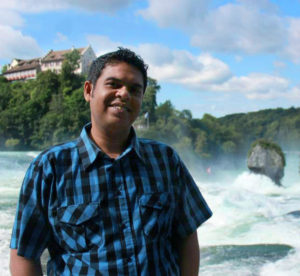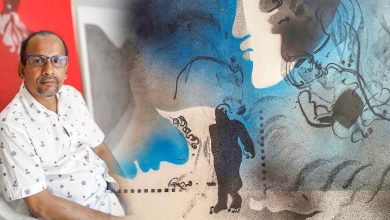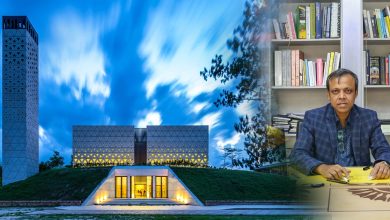The main focus of a mosque is worship. To ensure a suitable state of mind for such a private and sacred act, a mosque needs to impart a feeling of peace and tranquility. This should be the main objective behind building a mosque; any mosque.


Keeping that in mind, the Amber Denim Mosque constructed to ensure this effect. The mosque is built for the workers in the mill and provides a quiet place for them to focus on prayers. The mosque is situated at the premises of Amber Denim Mills, Jangalbaria, Gazipur.


The structure is completely devoid of luxury, eliminating any obstacle in the path of a worshipper’s focus. Instead, the path of vernacular architecture was adopted. Vernacular architecture is characterized by its reliance on needs, construction materials and traditions specific to its particular locality. It is a type of architecture which is indigenous to a specific time and place and not replicated from elsewhere.
The Denim Mosque is a low cost structure. In situ finishing materials are used instead of market materials.

This type of architecture is the simplest form of addressing human needs but is often seemingly forgotten in modern architecture. But the Denim mosque design does indeed fulfil the need and functionality that the structure deserves. In addition, the mosque shows a contemporary tropical expression. The essence of crafted modernism is evident in here.


A mosque is a sacred place. It requires isolation from the materialistic life. The surrounding water body provides a sense of isolation and the entrance bridge is a preparation space to create a mindset. The perforated screen allows the daylight to create a different set of mood in the different times of the day.


The water surrounding residential community (village) is a very common scene in Bangladesh. The water surrounding the mosque relates to that and it creates a sense of purity. The space inside the mosque was kept simple where users can have a calm atmosphere to pray.
The surrounding water body provides a sense of isolation and the entrance bridge is a preparation space to create a mindset.


The main attribute of this project was to implement the side-by-side existence of natural water and people. In rural Bangla, each village home has a small pond beside it. These homes in the rural setting are self-sustained, naturally ventilated. They exist in harmony with the surrounding nature and green. Design of The Denim Mosque also employs such a self-sustaining system. The mosque is completely naturally ventilated.


It celebrates the tradition of craft from rural Bangladesh. The perforated screen of the mosque withholds a sense of crafted modernism in style. Its installation technique is inspired by the rural technology of mud block installation.


The Denim Mosque is a low-cost structure. In situ finishing materials are used instead of market materials. The basic structure is mainly R.C.C and the screen is made of brick and handmade CC block. The floor is neat cement finished, the screen has hand-made concrete block walls, the roofing material is industrial sheet and the ceiling is made with pine wood. The mosque was completed entirely by locally available contractors and labour.



The space for prayer should be comfortable and pleasant, and Amber Denim Mosque succeeds in creating the perfect atmosphere for this. Every single thing in the design works in harmony to increase the tranquil bliss of the mosque.
[Photography by Maruf Raihan]Architect Bio:
 Lutfullahil Majid is a currently practising architect, inspired by the age-old, diversified architectural and cultural heritage of his country Bangladesh and the Sub-Continent. Born on 1st October 1981, he completed graduation from BUET in 2006. He is working as a Principal Architect and Partner in Archeground Ltd from February 2006. He received Berger Young Architect Award in 2015 for a Residence in Rampal, Khulna, Bangladesh; got shortlisted in Unity Complex Design Competition, 2012. The ideology of Master Architect Geoffrey Bawa is an inspiration for him.
Lutfullahil Majid is a currently practising architect, inspired by the age-old, diversified architectural and cultural heritage of his country Bangladesh and the Sub-Continent. Born on 1st October 1981, he completed graduation from BUET in 2006. He is working as a Principal Architect and Partner in Archeground Ltd from February 2006. He received Berger Young Architect Award in 2015 for a Residence in Rampal, Khulna, Bangladesh; got shortlisted in Unity Complex Design Competition, 2012. The ideology of Master Architect Geoffrey Bawa is an inspiration for him.




